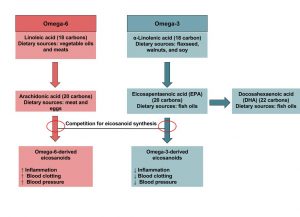Chapter 7: Lipids
7.4 Essential Fatty Acids
University of Hawai‘i at Mānoa Food Science and Human Nutrition Program
Fatty acids are vital for the normal operation of all body systems. The circulatory system, respiratory system, integumentary system, immune system, brain, and other organs require fatty acids for proper function. The body is capable of synthesizing most of the fatty acids it needs from food. These fatty acids are known as nonessential fatty acids. However, there are some fatty acids that the body cannot synthesize and these are called essential fatty acids. It is important to note that nonessential fatty acids doesn’t mean unimportant; the classification is based solely on the ability of the body to synthesize the fatty acid.
Essential fatty acids must be obtained from food. They fall into two categories—omega-3 and omega-6. The 3 and 6 refer to the position of the first carbon double bond and the omega refers to the methyl end of the chain. Both types of essential fatty acid are polyunsaturated fatty acids.
The structures of two of the most common essential fatty acids are shown below.


Our bodies can convert linoleic acid to other omega-6 fatty acids and alpha-linolenic acid to other omega-3 fatty acids, to some extent, but we cannot convert omega-3 fatty acids to omega-6 fatty acids, or omega-6 fatty acids to omega-3 fatty acids. Therefore, we need both to get both types of essential fatty acids in our diet.
Omega-3 and omega-6 fatty acids are precursors to important compounds called eicosanoids. Eicosanoids are powerful hormones that control many important body functions, such as the central nervous system and the immune system. Different eicosanoids are produced from different types of fatty acids, which leads to different health outcomes. Eicosanoids derived from omega-6 fatty acids are known to increase blood pressure, immune response, and inflammation. In contrast, eicosanoids derived from omega-3 fatty acids are known to have heart-healthy effects. Omega-3 fatty acids are considered anti-inflammatory because replacing the more inflammatory omega-6 fatty acid derived eicosanoids with omega-3 fatty acid derived eicosanoids will decrease inflammation.
In general, polyunsaturated fatty acids are considered healthy. However, since omega-6 fatty acids are more inflammatory, consuming too many omega-6s is probably more detrimental than helpful. As a result, many people talk about the omega-3:6 fatty acid ratio in peoples’ diets. For most Americans, the ratio is believed to be too high, at almost 10-20 times more omega-6 fatty acids than omega-3 fatty acids.[1] This is why you’ve probably heard that you should get more omega-3s in your diet.
Essential fatty acids play an important role in the life and death of cardiac cells, immune system function, and blood pressure regulation. Docosahexaenoic acid (DHA) is an omega-3 fatty acid shown to play important roles in synaptic transmission in the brain during fetal development.
Some excellent sources of omega-3 and omega-6 essential fatty acids are fish, flaxseed oil, hemp, walnuts, and leafy vegetables. Because these essential fatty acids are easily accessible, essential fatty acid deficiency is extremely rare. When it does occur, symptoms include impaired growth, reproductive problems, skin lesions, and neurological and visual problems.

Food Sources of Fatty Acids
After going through this wide array of fatty acids, you may be wondering where they are found in nature. The figure below shows the fatty acid composition of certain oils and oil-based foods. As you can see, most foods contain a mixture of fatty acids. Stick margarine is the only product in the figure that contains an appreciable amount of trans fatty acids. Corn, walnut, and soybean oil are rich sources of n-6 polyunsaturated fatty acids (a.k.a. omega-6 fatty acids), while flax seed is fairly unique among plants in that it is a good source of n-3 polyunsaturated fatty acids (a.k.a. omega-3 fatty acids). Canola and olive oil are rich sources of monounsaturated fatty acids. Lard, palm oil, butter and coconut oil all contain a significant amount of saturated fatty acids.

- 1. Simopoulos AP. (2008) The importance of the omega-6/omega-3 fatty acid ratio in cardiovascular disease and other chronic diseases. Exp Biol Med 233(6): 674. ↵
A polyunsaturated fatty acid is a fatty acid with two or more double bonds or two or more points of unsaturation.
In a trans fatty acid, the hydrogen atoms are attached on opposite sides of the carbon chain.
The term saturation refers to whether or not a fatty acid chain is filled (or “saturated”) to capacity with hydrogen atoms. If each available carbon bond holds a hydrogen atom we call this a saturated fatty acid chain.

